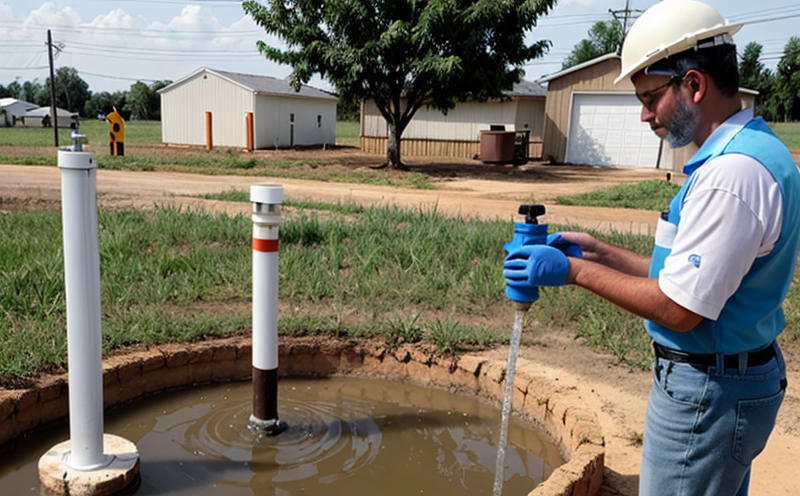EPA Method 1613 Dioxins in Groundwater
EPA Method 1613 is a comprehensive analytical procedure designed to quantify dioxins in groundwater, which are persistent and toxic contaminants. These compounds can originate from various sources such as industrial processes, waste incineration, and agricultural activities. The method is crucial for ensuring compliance with environmental regulations and safeguarding public health.
Groundwater contamination by dioxins poses a significant risk to ecosystems and human populations. Dioxins are highly toxic and can bioaccumulate in the food chain. EPA Method 1613 aims to provide accurate, reliable, and reproducible results that support regulatory compliance and environmental remediation efforts.
The method involves several critical steps including sample collection, transport, storage, and analysis using sophisticated instrumentation such as high-resolution gas chromatography (HRGC) coupled with mass spectrometry (GC-MS). This ensures the detection of even trace amounts of dioxins. Compliance with this method is essential for industries involved in water treatment and waste management.
To ensure robust results, EPA Method 1613 requires precise sample preparation and handling to prevent contamination or degradation of dioxin compounds. The analytical procedure must be conducted under strict conditions to minimize matrix effects that could interfere with the detection process.
This method is particularly important for facilities subject to stringent environmental regulations, such as those involved in hazardous waste disposal or industrial manufacturing processes. Accurate and consistent testing ensures compliance with regulatory standards and contributes to environmental protection efforts.
The reliability of EPA Method 1613 lies in its detailed protocols that cover every aspect from field sampling through laboratory analysis. This includes the use of certified reference materials (CRMs) for calibration and quality control, as well as rigorous validation procedures to ensure method performance over time.
By adhering to this stringent protocol, laboratories can provide accurate data on dioxin concentrations in groundwater samples, which is vital for informed decision-making regarding environmental remediation and regulatory compliance. The method's robustness allows it to be applied across various industries where groundwater quality is a critical concern.
Applied Standards
| Standard Reference | Description |
|---|---|
| EPA Method 1613 | Determination of Dioxins in Groundwater by High Resolution Gas Chromatography and Isotope Dilution Mass Spectrometry. |
| ISO 17025:2017 | Laboratory Accreditation Requirements |
Industry Applications
EPA Method 1613 is widely used in industries where groundwater contamination by dioxins could pose a significant risk. This includes:
- Hazardous waste disposal facilities
- Petrochemical and chemical manufacturing plants
- Electricity generation through coal combustion
- Landfills and solid waste management sites
In these sectors, accurate and reliable dioxin testing is crucial for ensuring compliance with environmental regulations. The method supports the identification of contaminated areas and guides remediation efforts to prevent further contamination.
Additionally, EPA Method 1613 plays a vital role in research and development (R&D) activities aimed at improving water treatment technologies and waste management practices. By providing precise dioxin concentration data, this method facilitates the design of more effective remediation strategies and the development of cleaner production processes.
Compliance with EPA Method 1613 is not only a regulatory requirement but also an ethical responsibility for industries that handle hazardous substances. It ensures that environmental impacts are minimized and public health risks are reduced.
Competitive Advantage and Market Impact
Employing EPA Method 1613 provides several competitive advantages for industries involved in water treatment and waste management:
- Precise and reliable data for regulatory compliance.
- Accurate identification of contaminated areas, enabling targeted remediation efforts.
- Enhanced reputation as a responsible environmental steward.
- Achievement of cost-effective solutions through informed decision-making.
By using this method, companies can demonstrate their commitment to environmental sustainability and public health. This not only enhances brand image but also fosters trust among stakeholders, including regulatory bodies, customers, and the general public.
In the competitive landscape of water treatment and waste management, compliance with EPA Method 1613 sets a benchmark for excellence in environmental stewardship. It allows companies to stay ahead by ensuring they meet or exceed industry standards, thereby reducing risks associated with non-compliance.
The method's robustness also contributes to market differentiation, as it provides consistent and accurate results that are critical for maintaining operational efficiency and regulatory compliance. This translates into a competitive edge in the marketplace by ensuring sustainable business practices.





